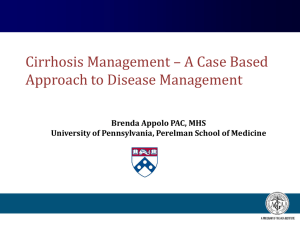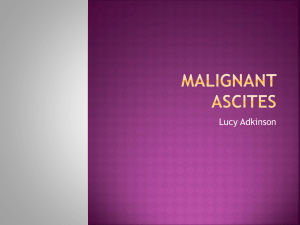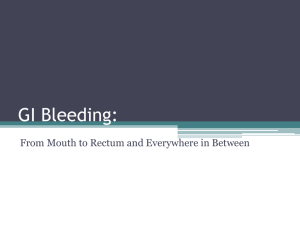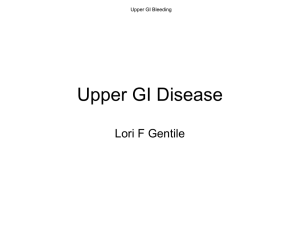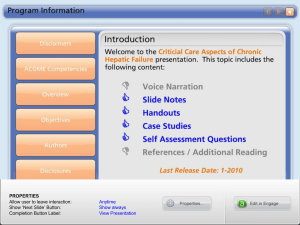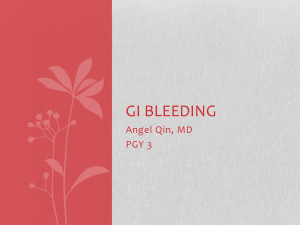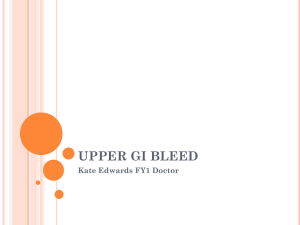Liver Cirrhosis
advertisement
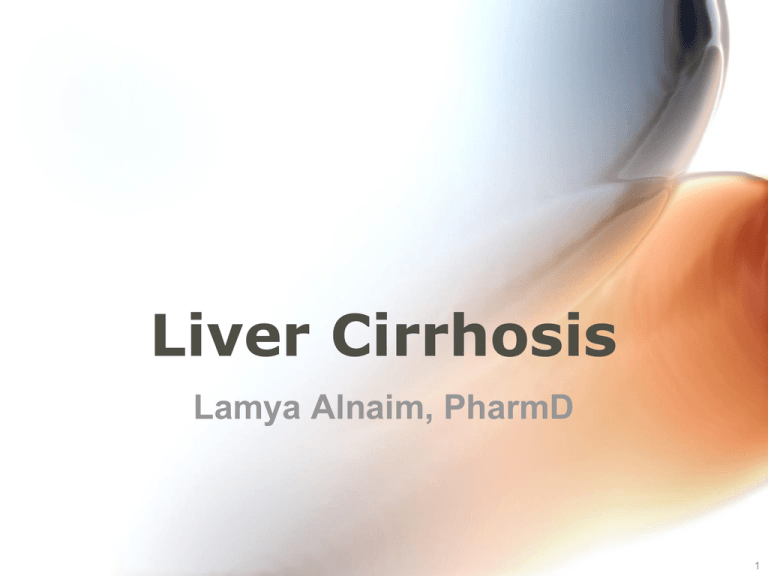
Liver Cirrhosis Lamya Alnaim, PharmD 1 Background • Cirrhosis →the end stage of any chronic liver disease. • Hepatitis C and alcohol are the main causes • Two major syndromes result – Portal hypertension – Hepatic insufficiency. • peripheral and splanchnic vasodilatation with the resulting hyperdynamic circulatory state 2 Background • Cirrhosis can remain compensated for many years before the development of a decompensating event. • Decompensated cirrhosis is marked by the development of any of the following complications: – – – – Jaundice, Hemorrhage Ascites Encephalopathy. • Other than liver transplantation, there is no specific therapy for this complication. 3 Background • Other complications occur as a consequence of PHTN and the hyperdynamic circulation. • Gastroesophageal varices result from PHTN, although hyperdynamic circulation contributes • Ascites results from sinusoidal HTN and sodium retention, which is 2ndry to vasodilatation and activation of neurohumoral systems. 4 Background • The hepatorenal syndrome results from severe peripheral vasodilatation that leads to renal vasoconstriction. • Hepatic encephalopathy is a consequence of shunting of blood through portosystemic collaterals (due to PHTN), brain edema (cerebral vasodilatation), and hepatic insufficiency. 5 Definition • A chronic disease of the liver with wide spread hepatic parenchymal injury and hepatocyte destruction. • It may lead to anatomic and functional abnormalities of blood vessels and bile ducts 6 Causes • Alcohol • Viral illness • Biliary dysfunction • Metabolic disorders • Inherited disorders • Drugs • The most common causes are alcoholism and viral hepatitis 7 Clinical Features • Insidious development • Often produces no clinical manifestations • Common symptoms – Anorexia, nausea, abdominal discomfort, weakness, weight loss, and malaise 8 Clinical Features • Physical examination: – Enlargement of the liver and spleen due to PHTN – ascities, – peripheral edema, – Jaundice – Spider angiomas – GI bleeding – Palmer erythema – Right upper quadrant pain 9 Portal Hypertension • Portal vein collects blood from GI tract, pancreas and spleen to the liver • Contains oxygen, nutrients and bacterial waste • A pathway for detoxification and metabolism of absorbed substance. • Fibrosis and nodular regeneration of liver with distortion of hepatic veins is the main cause of ↑ intrahepatic resistance 10 Portal Hypertension Persistent PHTN lead to • Changes in blood and lymphatic flow → hyperfiltration and ascites • ↑ collateral circulation ↑ the risk for esophageal and gastric varices • Hepatic encephalopathy and hepatorenal syndrome 11 Lab Findings • Bilirubin> 2mg/dl to 40 mg/dl • AST, ALT, alkaline phosphatase – Aid in early diagnosis, prognosis, and response to treatment – ↑ ALkPo > 3 times normal indicate billiray disease 12 Lab Findings Albumin • (non-specific protein) & Factor V and VII (specific proteins) can provide information on the functional capacity of the liver • Low albumin < 3 that does not respond to therapy is bad prognosis 13 Lab Findings •PT – Prolongation due to impaired synthesis of vitamin K dependant clotting factors – No response to VIT K is poor prognosis •BUN – < 5 due to inadequate protein intake and depressed hepatic capacity for urea synthesis •Biopsy – Confirm the presence of cirrhosis 14 General Management • Largely symptomatic • Maintain fluid and electrolyte balance 15 General Management • Analgesics: – NSAIDs may worsen gastritis and GI bleeding – Acetaminophen may lead to hepatoxicity – Narcotics may lead to CNS and respiratory depression – Sedatives and hypnotics should be avoided if the patient is in danger of hepatic coma 16 General Management • Diet –2000-3000 calorie diet with 1g protein/kg –In encepalopathy, dietary supplentation of BCAAs –Thiamine replacement 50-100mg/da –Iron and folate if patient is anemic –Vitamin K 10 mg sc if PT is elevated, if PT is not improved in 3-5 days D/C 17 I-Ascities Definition: • Accumulation of protein rich fluid in the peritoneal cavity. • The most common clinical feature Clinical features: • Inability to fit into one's clothes • Abdominal and back pain • Gateroesophageal reflux • SOB secondary to impaired diaphragm movement Or pleural effusions 18 Ascities Pathophysiology: Underfill theory 1-↑ hydrostatic pressure in portal vein and ↓ oncotic pressure. – Exudation of fluid from the splanic capillary bed and liver surface when drainage capacity of the lymphatic system is exceeded. 19 Ascities Pathophysiology: Underfill theory 2-Portal hypertension & ↓ oncotic pressure →↓ arterial blood flow to vital organs → vasoconstriction. – Reduced circulation to kidney activate rennin angiotension sys → ↑ aldosterone & Na/ water retention. – Renal K excretion > Na excretion & urinary Na: K ratio abnormal. 20 Ascities Goals of therapy • Mobilize fluid • Diminish abdominal discomfort, back pain, and difficulty in ambulation • Prevent complications such as bacterial peritonitis, hernias, pleural effusion, hepatorenal syndrome, respiratory distress. • Prevent complications of treatment such as acid-base imbalance, hypokalemia, and volume depletion 21 Ascities -Treatment A- Sodium Restriction: (500mg2g/day) –10-20 mEq/day plus bed rest (to ↓rennin) • Degree of success depends on: –Duration of restriction –Extent of hepatic injury –Patient with urine Na >10 mEq/l likely respond 22 Ascities -Treatment B-Water Restriction –Effective in dilutional hyponatremia (Na<130) –Patients with low urine sodium <10 mEq/l –Normal renal function • Not effective in –reduced 24-hour Na urinary excretion –Reduced GFR & free water clearance –May lead ↓ renal blood flow and azotemia 23 Ascities -Treatment C. • • • Diuresis The cornerstone of treatment Must be slow If urinary losses > reabsorption from ascites→ volume depletion , hypotension and renal insufficiency • Should be limited to 0.2-0.3 kg /day in patients without edema • 0.5-1kg /day for patients with edema 24 Ascities -Treatment I- Spironolactone • An aldosterone-inhibiting agent • Patients have high levels of aldosterone • Increased production – Portal hypertension, ascities, ↓ intravascular volume, ↓ renal blood flow activate rennin-ang system • Decreased excretion – Hepatic impairment prolongs half-life due to metabolism ↓ – ↓ albumin ↑ unbound hormone in the blood • Dose: 100-200 mg/day, may be every 2-4 days ↑ slowly 25 Ascities -Treatment I- Spironolactone Monitoring Parameters • weight • urine output • changes in abdominal girth • BUN • Increase in K/Na ratio from pretreatment baseline • Table 26 Complication of Spironolactone 1-Hypokalemic hyperchloremic metabolic alkalosis and hyponatermia • May occur in untreated cirrhosis • Initial deficiency of K due to diarrhea, vomiting, hyperaldosterone • May be corrected with KCl supplement • Hyponatermia corrected by temporary withdrawal of diuretic and free water restriction 2- Prerenal azotemia • ARF due to overdiuresis with compromise in intravascular volume and decreased renal perfusion • gradual rise in Scr and Bun • If large fluid volume must be removed quickly, paracentesis should be preformed 3- Gynecomastia: • can be related to cirrhosis independent of drug use 27 Ascities -Treatment II-Other Diuretics • If spironolactone fails to produce diuresis or hyperkalmeia occurs additional diuretic are needed • The dose should be started low 50 mg/day HCTZ or 20-40 mg furosemide and gradually increased • Loop and thiazide diuretics may affect the value of monitoring urinary electrolyte • The may cause excessive sodium loss in the presence of continued hyperaldosteronism 28 Ascities -Treatment D- Paracentesis Removal of large amount of ascetic fluid with a needle or catheter Uses • Ascites unresponsive to diuretic therapy • If respiratory and cardiac functions are compromised • Not definitive because fluid quickly reaccumliated due to transudation of fluid from the interstitial and plasma 29 D- Paracentesis Major complications • 15-100% of the fluid reaccumlates with 24-48 hrs → transient hypovolemia and possibility of shock, encaphalopathy and ARF • Hypotension • Hemconcentration 30 D- Paracentesis Major complications • Shock • Oliguria • Hepatorenal syndrome • Hemorrhage • Perforation of abdominal vicra • Infection, bacterial peritonitis • Protein depletion 31 E- Albumin • Combined with paracentesis • Effective as the initial management in tense ascites Typical regimen: Removal of 4-6 l/day with replacement of 40-50g of albumin 32 E- Albumin Benefits of combination: • More ascetic fluid can be removed • Shorter hospital stay • Superior to diuretic therapy • No worsening of hepatic, renal or CV function • Albumin alone can promote diuresis in ascites & edema by increasing intravascualr volume • The effects are not long lasting • Variceal hemorrhage may be precipitated 33 F- Dextran 70 • Can be combined with paracentesis • Equally effective to albumin in mobilizing ascities • More cost-effective • Does not correct the underlying hemodynamic abnormalities, so albumin is preferred 34 G-Surgical therapy 1- Peritoneovenous shunt •An implanted valve in the abdominal wall, with cannula that empties into the vena cava •Urine output as high as 15 L in 24 hrs •Supplemental fruosamide may be needed to prevent vascular overload 35 G-Surgical therapy 1- Peritoneovenous shunt Contraindications: – – – – – Peritonitis, Recurrent coma Sever coagulopathy Significant cardiac failure Acute alcoholic hepatitis 36 G-Surgical therapy 1- Peritoneovenous shunt Complication – Pulmonary edema – Coagualopahty – Fever, Wound infection, Septicemia, GI bleeding •Reserved for patients with good renal and hepatic function who fail standard therapies 37 G-Surgical therapy 2-transjugular intrahepatic portosystemic shunt (TIPS) •a radiologic procedure in which a stent is placed in the middle of the liver to reroute the blood flow. •it makes a tunnel through the liver connecting the portal vein to one of the hepatic veins. •A metal stent is placed in this tunnel to keep the track open. 38 SBP • SBP is an infection of ascites that occurs in the absence of a contiguous source of infection. • SBP occurs in 10 to 20 % of hospitalized cirrhotic patients. • Early diagnosis is a key issue in the management of SBP. • SBP pathogenesis in patients with cirrhosis is considered • to be the main consequence of bacterial translocation. 39 SBP-Predisposing factors • Severity of liver disease • Total ascites protein <1 g/dL • GI bleeding • Bacteriuria • Previous SBP Recurrence rates: 43% by 6 mts, 69% by 1 yr and 74% by 2 yrs 40 SBP-Clinical features • signs may be absent in up to 1/3 • fever/hypothermia • abdominal pain and tenderness • hepatic encephalopathy • diarrhoea • ileus • shock • Unexplained deterioration in a patient with cirrhosis and ascites should lead to diagnostic paracentesis 41 SBP-diagnosis A diagnostic paracentesis should be performed in • Any patient admitted to the hospital with cirrhosis and ascites, • Any cirrhotic patient who develops compatible symptoms or signs • Any cirrhotic patient with worsening renal or liver function. • Diagnosis is established with an ascites PMN of > 250/mm3 42 SBP- Treatment • Once an ascites PMN count of >250/mm3 is detected, and before obtaining the results of ascites or blood cultures, antibiotic therapy needs to be started. • The antibiotic that has been most widely used in the treatment of SBP is IV cefotaxime (2g 8 hrly) with which SBP resolves in around 90 90% of treated patients 43 SBP- Treatment • The combination of amoxicillin and clavulanic acid was shown to be as effective and safe as cefotaxime • Antibiotic treatment can be safely discontinued after the ascites PMN count decreases to below 250/mm3 • duration of antibiotic therapy should be for a minimum of 8 days 44 The following interventions are recommended based on controlled trials or cohort studies demonstrating infection cure rates of around 90 percent: Intravenous cefotaxime or other third-generation cephalosporins (ceftriaxone) for a duration of 5 to 8 days Intravenous ampicillin/sulbactam is an alternative In patients with community-acquired SBP, no renal dysfunction, no encephalopathy, and a low prevalence of quinolone-resistant organisms, an orally administered widely bioavailable quinolone (ofloxacin, levofloxacin) is an alternative In patients with renal dysfunction, intravenous albumin at a dose of 1.5 g/kg body weight on the first day and 1 g/kg body weight on the third day The following interventions are not recommended based on clinical trials, uncontrolled studies demonstrating that other interventions are either more effective or safer, as well as theoretical considerations: Aminoglycoside-containing antibiotic combinations Procedures and medications that will decrease intravascular effective volume (e.g., large volume paracentesis, diuretics) The following intervention is under evaluation and cannot be widely recommended until additional information is available: Intravenous albumin as an adjunct to antibiotic therapy 45 Prevention of recurrent SBP • In patients who survive an episode of SBP, the 1-year cumulative recurrence rate is high, at about 70 %. • It is essential that patients be started on antibiotic prophylaxis to prevent recurrence before they are discharged from the hospital. 46 Prevention of recurrent SBP • Long-term prophylaxis with oral norfloxacin at a dose of 400 mg QD • treatment should be initiated as soon as the course of antibiotics for the acute event is completed. • oral ciprofloxacin at a dose of 250 mg QD could be used, although levofloxacin may be a better alternative given its added grampositive coverage. 47 Prevention of recurrent SBP • Weekly administration of quinolones is not recommended given a lower efficacy and an increase in the development of fecal quinolone-resistant organisms. • Prophylaxis should be continuous until disappearance of ascites (i.e., patients with alcoholic hepatitis who stop drinking) or transplant 48 The following interventions are recommended based on randomized clinical trials or expert opinion: Oral norfloxacin at a dose of 400 mg QD (not on VA National Formulary) Oral ciprofloxacin or levofloxacin at a dose of 250 mg QD The following intervention is not recommended based on clinical trials or uncontrolled studies demonstrating that other interventions are either more effective or safer: Weekly administration of quinolones The following intervention is under evaluation and cannot be recommended until additional information is available: Trimethoprim/sulfamethoxazole 49 50 Esophageal varices Definition • Compensatory hemodynamic mechanism due to PHTN • Shunting of blood supply through low-pressure collateral veins in the esophageaus, rectum. • ↑ pressure in the gastric fundus and esophagus cause swelling and burst resulting in life threatening upper GI bleeding • Bleeding may be ↑ by impaired clotting system caused by deficincies of vitamin K dependant clotting factors • It is the leading cause of death in cirrhosis • Considered a medical emergency 51 Esophageal varices Goals of therapy • Volume resuscitation • Acute treatment of bleeding • Prevention of recurrence 52 EV-General Management Resuscitation • Gastric lavage with suction of gastric fluid to prevent complication as aspiration & pneumonia • Pharmacological treatment to stop bleeding • If PT > 15 sec, INR. 1.7 give 10mg IV vitamin K • Monitor electrolytes, blood gases, and urine output Hypovolemia • Signs: Pallor, cold clammy skin, rapid pulse, SBp < 80 mmHg • Blood and blood products transfusion • Keep HCT > 30% • Whole blood is preferred due to homeostatic properties 53 Therapy of Bleeding Varices 1-Vassopressin • Powerful non-specific vasoconstrictor that reduces blood flow in the splanchnic bed • Effective in 60% of patients • short half-life and must be given as CIV • May be used before sclerotherpay to slow bleeding and visualize varices 54 Therapy of Bleeding Varices 1-Vassopressin • Dosing • Use lowest effective dose because ADRs dose related • IV bolus 20U → IVI of 0.2-0.4 u/min Max 0.9 u/min • Taper dose over 24-48 hrs when bleeding controlled 55 1-Vassopressin SE: • Intense vasoconstrictor action decreases C.O. and may cause coronary ischemia • Bradycardia due to stimulation of the vagus nerve • Abdominal cramping and Skin blanching due to stimulation of smooth muscle contraction • Phlebitis • Hematoma at the site of infusion • Excess water retention and dilutioanl hyponatremia 56 Therapy of Bleeding Varices 2-Terlipressin • A synthetic analogue • 80% effective • Longer half-life and can be give as bolus every 6 hrs • Dose 2 mg • Less cardiac side effects have been reported 57 Therapy of Bleeding Varices 3-Somatosatin • Natural peptide with shorter half life • Dose: bolus 50-250 mcg, infusion 250500 mcg/hr • Similar efficacy to vasopressin but les side effects and higher cost 4- Octreotide • Synthetic analogue of somatostatin • Selective, potent vasoconstrictor that reduces portal and collateral blood flow • Comparable efficacy to vasopressin • Dose: bolus 50-100 mcg followed by infusion 25-50 mcg/hr 58 Sclerotherapy • Insertion of a flexible fiberoptic esophagoscope to directly visualize and inject a sclerosing agent in varices to induce immediate homeostasis →intense inflammation → thrombus formation and cessation of bleeding in 2-5 minutes • Permanent destruction of the vessel over several days • Procedure may need to be repeated several times 59 Sclerotherapy • Treatment of choice • 95% effective • More effective that vasopressin and balloon tamponade • Following scleotherapy, prophylaxis with antacids, histamine blockers, omeprazole or suclafate 60 Sclerotherapy Complications • Esophageal ulceration • Stricture formation • Esophageal perforation • Retrosternal chest pain • Temporary dysphasia Sclerosing agents • Sodium tetradecyl sulfate • Ethanolamine oleate • 0.5-2 ml of the solution is injected 61 Therapy of Bleeding Varices Alternative treatments: Balloon tamponade • After initial sclerotherapy fails before trying a second sclerotherapy • Used for acute treatment • 90% effective • Direct compression of the varices • Temporary procedure limited to time balloon is inflated • An additional procedure required within 24 hrs 62 Therapy of Bleeding Varices Alternative treatments: Balloon tamponade Complication • Aspiration • Pneumonitis • Esophageal ulceration • And rupture • Chest pain • Asphyxia 63 EV-Long-Term Management 1- Propranolol • Used for secondary prophylaxis • To reduce hepatic flow and portal pressure • Beneficial in alcoholic cirrhosis and less advanced disease • Does not decrease mortality • Abrupt discontinuation may lead to rebreeding 64 EV-Long-Term Management 2- Endoscopic Band Legation • An elastic band is placed around the mucus a and submucosa of the esophageal area containing the varix • Leading to strangulation and fibrosis of the varix as effective as sclerotherpay with less complications • Effective in preventing rebreeding 3-Surgery 65 EV-Long-Term Management Primary prophylaxis • Primary prevention of bleeding episode 1-Beta-Blockers • Studies shown beta blockers to prevent bleeding • Using 25% reduction in heart rate or hepatic venous gradient • Propranolol and nadolol have been used • They do not increase survival 66 EV-Long-Term Management Primary prophylaxis 2-Isosorbide mononitrate • Can reduce portal pressure • Combination with propranolol has greater reduction in pressure • Similar efficacy to propranolol, with regard to bleeding and survival 3-Sclerotherpay • As a primary preventive measure has a higher mortality rate and is not recommended 67 3-Hepatic Encephalopathy • a metabolic disorder of the CNS and occurs in patients with advanced cirrhosis or fulminate hepatitis. Clinical Features • Altered mental status • Fetor heapticus : sweetish musty pungent odor of the breath • Asterixis: flapping tremor, non=specific • Personality changes • Drowsiness and confusion • Deep coma, reversible 68 Pathogenesis-HE 1- Ammonia • The byproduct of protein metabolism • Large portion is derived from diet or blood in the GIT • Ammonia is metabolized to urea, which is renally eliminated 69 Pathogenesis-HE 1- Ammonia • In cirrhosis serum and CNS ammonia are increased • In the CNS it combines with alphaketogluarate to form glutamine an aromatic amino acid. • High glutamine in CSF is characteristic of encephalopathy , but it may not be the only cause 70 Pathogenesis 2-Amino acid balance • normal ratio of branched to aromatic AA is 4-6:1 • Catabolic state → -ve nitrogen balance and preferential use of BCAAs as a source of energy 71 Pathogenesis • As liver failure progress → liver no longer produce glucose for energy → BCAA used by skeletal muscle → ↓ their level in the blood. • Plasma clearance of AAAs is ↓ • The blood brain barrier become more permeable to AAA via exchange for glutamine in the CSF 73 Pathogenesis • In the CSF the aromatic compounds are metabolized into chemicals that disrupt normal neurotransmitter balance • E.g. tryptophan is converted to serotonin, which can compete with norephineprine for normal CNS function 74 Pathogenesis 3-Gamma-aminobuyteric acid (GABA) • GABA is the primary inhibitory neurotransmitter in the CNS • Activation of GABA receptors results in increased Chloride permeability, hyper polarization of the neuronal membrane, and inhibition of neurotransmission. • GABA binds to postsynaptic receptors sites in the brain, and causes the neurological abnormalities associated with hepatic encephalopathy. 75 Precipitating factors • Increase the serum ammonia or produce excessive somnolence in patients with impending hepatic coma • Excess nitrogen load and metabolic or electrolyte abnormalities may increase ammonia levels 76 A- Excess nitrogen load 1- GI bleeding Varices Hemorrhoids Peptic ulcer Bacterial degradation of blood proteins result in absorption of large amounts of ammonia and toxins 2- Excess dietary proteins 3- Azotemia Diuretic induced hypovolemia Uremia of renal failure Excessive introhepatic circulation of BUN Induce prerenal azotemia, and promote hypokalemia, and alkalosis, 77 4-Infection 5-Constipaiotn Increased tissue catabolism ↑ ammonia generation due to ↓ gut transient time 78 Metabolic and electrolyte abnormalities 1-Hypokalemaia Increases the Diuretic induced concentration of Dietary deficiency ammonia in renal Excessive diarrhea venous blood Hyperaldosteroism 2-Alkalosis Promotes diffusion of Hypokalemia nonionic ammonia Excessive nausea and vomiting and other amines into CNS 79 Drug-induced CNS depression Sedatives Tranquilizers Narcotic analgesics Increased CNS sensitivity and decreased hepatic clearance which lead to accumulation Also bound drugs increase their free fraction. 80 Treatment 1-removal of precipitating factor 2-reducing the amount of ammonia or nitrogenous products in the blood 3- Stop or limit protein intake at the onset of encephalopathy • May be increased at 10-20 g/day every 2-5 days depending on the clinical condition. • Vegetable protein may be better tolerated because they contain fewer methionine and aromatic amino acids are less ammoniagenic 81 Drug Therapy 1-Lactulose • A disaccharide broken down by GI bacteria to lactic, acetic, and formic acid • MOA: – acidification of the colon to convert NH3 → less absorbed NH 4+ → lower plasma NH3 – Induce osmotic diarrhea decreases intestinal transient time available for NH3 production and absorption. • Dose – Syrup 10g/15 ml – Acute: 30-45 ml TID titrated to resolution of symptoms & 3 soft stools /day. – In coma : rectal retention enema 1:3 lactulose in tap water – Effects appear in 24-48 hrs 82 Drug Therapy-Lactulose • Precautions –Avoid excessive diarrhea because it could lead to dehydration and hypokalemia which could exacerbate encephalopathy –20% may have gaseous distention, flatulence, belching 83 Drug Therapy 2-Neomycin •MOA: – reduces plasma ammonia levels by decreasing protein metabolizing bacteria in the GI tract •Dose: – 1-2 g orally QID – 1% retention solution as retention enema foe 20-60 min QID 84 Drug Therapy -Neomycin • Precautions – 1-3% of the dose can be absorbed and may cause ototoxicity or nephrotoxicity especially with chronic use in patients with renal failure. – Monitor serum creatinine, protein in the urine, CrCl when using high doses are used for long periods – May lead to reversible malabsorption syndrome that may decrease absorption of fat, iron, vit B digoxin, penicillin, and vit K • Comparison – Similar effectiveness – Neomycin produces a faster response in acute case – A patient who does not respond to one may respond to the other 85 Drug Therapy • Combination – May be more effective than either drug alone – Sterilization of gut bacteria by neomycin may impair bacterial degradation of lactulsoe and prevent colonic acidification – A stool PH < 6.0 reflects synergistic effects – Lactulose alone is preferred for long term use – Always try lactulose first if no response try neomycin, then try combination 86 Drug Therapy 3-Branched chain amino acids •Diets high in BCAA and low in AAAs may help restore normal AA balance and reduce encepalopathy •Heptamine is marketed as an 8% AA solution and contains more BCAAs than standard parental solutions •Indications – Due to high cost and limited efficacy information Patients with life threatening encepalopathy refractory to conventional therapy and with documented elevated serum ammonia levels •Hepatic-aid- Dietary supplement 87 Drug Therapy 4-Flumazenil • A benzodiazepine antagonist • Bases on GABAergic neurotransmission in hepatic encephalopathy • Demonstrated clinical improvement • Dose: chronic: 25 mg BID 88
